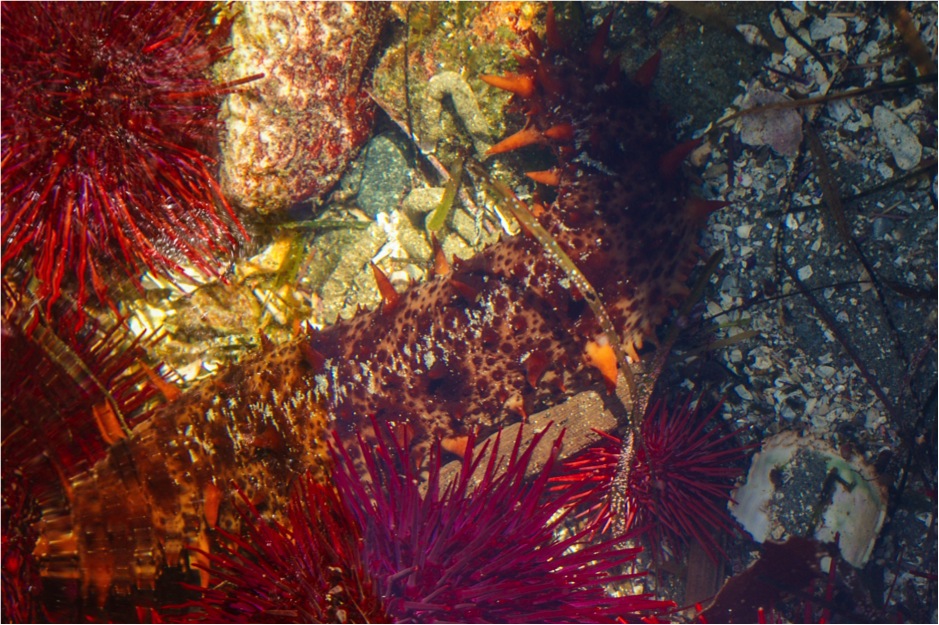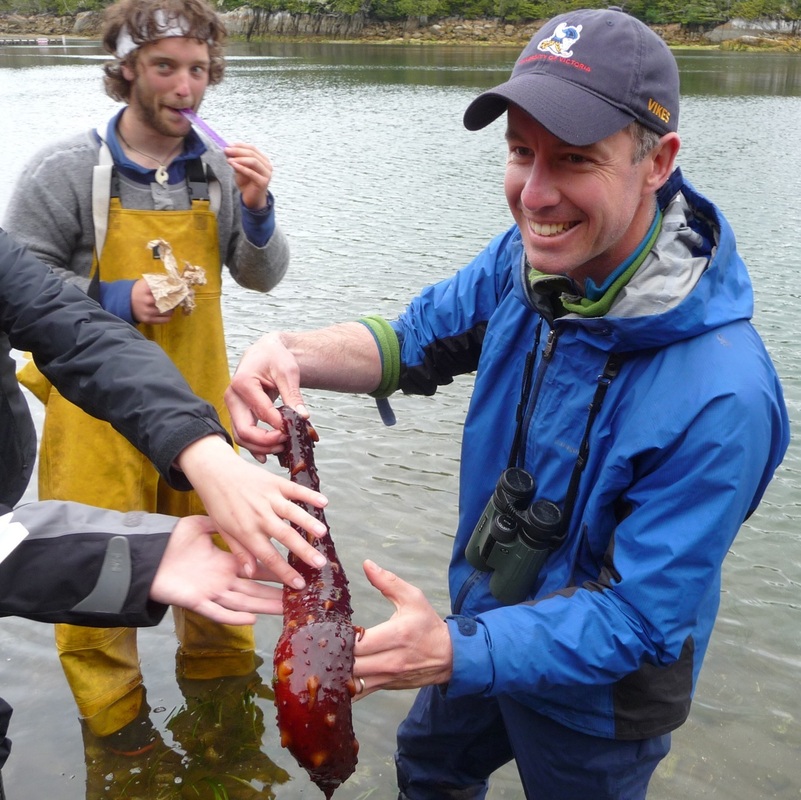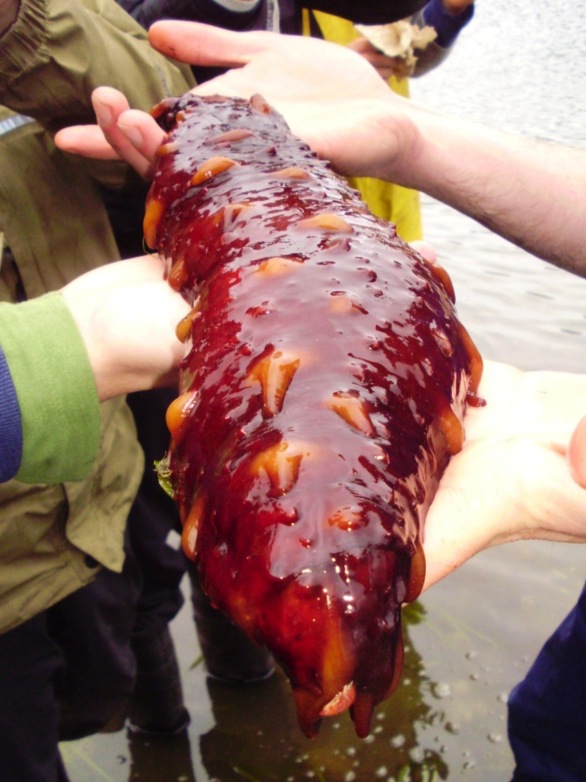Giant red sea cucumber • Parastichopus californicus • Heiltsuk/Haíɫzaqv - H̓ḷ̓ás
|
Top left: a giant sea cucumber among red sea urchins. Photo by Cody Gold. Bottom left and right: a specimen held up for examination demonstrates why this species, which reaches 50 cm long, has the common name of 'giant sea cucumber.' Photos by Elizabeth Bailey (right) and an ES 470 participant.
|
Identification
At a maximum length of 50 cm, the giant red sea cucumber is the biggest sea cucumber species in Pacific Northwest waters. Its elongated body bears cone-shaped papillae (projections) of varying sizes along its length, and 20 short bushy tentacles at one end. The giant red sea cucumber varies in colour, though it is often dark red to reddish-brown, mottled brown, or yellow-brown. Individuals may occasionally be lighter or even white. The underside tends to be a light cream colour; the papillae are usually lighter-coloured as well.
Habitat & Range
The giant red sea cucumber lives in a variety of intertidal and subtidal habitats: it can be found on sandy, rocky, muddy, and gravelly substrates on exposed to sheltered shorelines, to a depth of 250 m. It tends to be more abundant in calm locations with hard sea floor substrates, where detritus can settle to the bottom making feeding easier.
Human Uses
This species is harvested commercially for consumption: the internal muscle strips and the body wall are especially valued in some Asian countries. Giant red sea cucumber fisheries exist in British Columbia, Alaska and Washington. Only populations in more accessible areas are targeted, and so large areas of the Pacific Northwest coastline have not been subject to sea cucumber harvests. While giant red sea cucumbers are found up to 250 deep, harvests are limited to the safe diving depth of 20 m.
Intriguing Info
While the smaller orange sea cucumber (Cucumaria miniata) feeds on suspended particles, the giant red sea cucumber instead moves along the ground, using its sticky tentacles to feed on detritus and small organisms in sediments on the sea floor. From September to March it stops feeding and becomes dormant. It is preyed on by sea stars, such as the sunflower star (Pycnopodia heliathoides), as well as sea otters (Enhydra lutris) and some fish species.
iNaturalist
https://www.inaturalist.org/taxa/202640-Apostichopus-californicus
At a maximum length of 50 cm, the giant red sea cucumber is the biggest sea cucumber species in Pacific Northwest waters. Its elongated body bears cone-shaped papillae (projections) of varying sizes along its length, and 20 short bushy tentacles at one end. The giant red sea cucumber varies in colour, though it is often dark red to reddish-brown, mottled brown, or yellow-brown. Individuals may occasionally be lighter or even white. The underside tends to be a light cream colour; the papillae are usually lighter-coloured as well.
Habitat & Range
The giant red sea cucumber lives in a variety of intertidal and subtidal habitats: it can be found on sandy, rocky, muddy, and gravelly substrates on exposed to sheltered shorelines, to a depth of 250 m. It tends to be more abundant in calm locations with hard sea floor substrates, where detritus can settle to the bottom making feeding easier.
Human Uses
This species is harvested commercially for consumption: the internal muscle strips and the body wall are especially valued in some Asian countries. Giant red sea cucumber fisheries exist in British Columbia, Alaska and Washington. Only populations in more accessible areas are targeted, and so large areas of the Pacific Northwest coastline have not been subject to sea cucumber harvests. While giant red sea cucumbers are found up to 250 deep, harvests are limited to the safe diving depth of 20 m.
Intriguing Info
While the smaller orange sea cucumber (Cucumaria miniata) feeds on suspended particles, the giant red sea cucumber instead moves along the ground, using its sticky tentacles to feed on detritus and small organisms in sediments on the sea floor. From September to March it stops feeding and becomes dormant. It is preyed on by sea stars, such as the sunflower star (Pycnopodia heliathoides), as well as sea otters (Enhydra lutris) and some fish species.
iNaturalist
https://www.inaturalist.org/taxa/202640-Apostichopus-californicus
References
Adams, M.J. (2005). Parastichopus californicus (California sea cucumber). Beach Watchers. Washington State University. Accessed 12/11/2014.
Harbo, R. M. (2011). Whelks to whales: Coastal marine life of the Pacific Northwest [revised]. Madeira Park, BC: Harbour Publishing. P. 186.
Lamb, A., and Hanby, B. (2005). Marine Life of the Pacific Northwest [electronic version]. Madeira Park, BC: Harbour Publishing.
Lambert, P. Parastichopus californicus (Stimpson, 1857). In Klinkenberg, Brian. (Ed.) E-Fauna BC: Electronic Atlas of the Fauna of British Columbia. Lab for Advanced Spatial Analysis, Department of Geography, University of British Columbia, Vancouver. Accessed 12/11/2014.
Mercier, A., Hamel, J.-F., Toral-Granda, T.-G., Alvarado, J.J., Paola Ortiz, E. & Benavides, M. (2013). Parastichopus californicus. The IUCN Red List of Threatened Species. Version 2014.2. Accessed 12/11/2013.
Williams, K., Helmstetler, H., Cowles, D. (2005). Parastichopus californicus (Stimpson, 1857). Invertebrates of the Salish Sea. Rosario Beach Marine Laboratory. Accessed 12/11/2014.
Authors and editors of page
Kelly Fretwell and Brian Starzomski (2014).
Adams, M.J. (2005). Parastichopus californicus (California sea cucumber). Beach Watchers. Washington State University. Accessed 12/11/2014.
Harbo, R. M. (2011). Whelks to whales: Coastal marine life of the Pacific Northwest [revised]. Madeira Park, BC: Harbour Publishing. P. 186.
Lamb, A., and Hanby, B. (2005). Marine Life of the Pacific Northwest [electronic version]. Madeira Park, BC: Harbour Publishing.
Lambert, P. Parastichopus californicus (Stimpson, 1857). In Klinkenberg, Brian. (Ed.) E-Fauna BC: Electronic Atlas of the Fauna of British Columbia. Lab for Advanced Spatial Analysis, Department of Geography, University of British Columbia, Vancouver. Accessed 12/11/2014.
Mercier, A., Hamel, J.-F., Toral-Granda, T.-G., Alvarado, J.J., Paola Ortiz, E. & Benavides, M. (2013). Parastichopus californicus. The IUCN Red List of Threatened Species. Version 2014.2. Accessed 12/11/2013.
Williams, K., Helmstetler, H., Cowles, D. (2005). Parastichopus californicus (Stimpson, 1857). Invertebrates of the Salish Sea. Rosario Beach Marine Laboratory. Accessed 12/11/2014.
Authors and editors of page
Kelly Fretwell and Brian Starzomski (2014).







